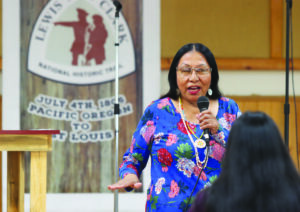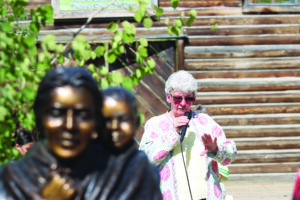
by John Dowd
On Monday, June 26, the Bitterroot Heritage Civic Group celebrated Darby’s “Sacajawea Day” with several presentations about the historic woman and her fascinating life’s impact. The event started at Sacajawea’s Rest Park and progressed to the Darby Community Clubhouse.
The park was created in 2018 as a monument to the famous Shoshone woman, with help from Trapper Peak Job Corps. It is located in what used to be an old cafeteria that burned down. The park includes a brass sculpture of Sacajawea and her son, Jean Baptiste Charbonneau. The park will eventually include several art pieces done by students at Darby High School and a large wall mural, to be completed this year.
The event was kicked off by the first speaker, Jayne Azzarello, a member of the Bitterroot Heritage Civic Group, and the artist who will be managing the mural project. She spoke at the park about the mural’s background and the events that lead Lewis and Clark to the Bitterroot.

The mural will be on the north wall of the park, featuring Sacajawea and a line of horses, symbolizing one of the most important contributions she made while the expedition was moving through western Montana and the area in which the park stands today.
The funding for the mural was provided by the Lewis and Clark Trail Stewardship Endowment, as well as by the town of Darby and others. The mural project will commence as soon as the weather “levels out,” explained Azzarello. This will allow the volunteers working on the mural project to clean and prime the wall for the mural. She explained that this will probably start some time after the fourth of July.
Once Azzarello was done, the audience and speakers moved to the Darby Community Clubhouse. Before the next speakers were introduced, there were several raffles and a vote for a t-shirt competition. Beans were dropped into cups by those who attended the event to vote on drawings submitted by the Darby Elementary School.
The West Fork Mountain Crafts, located in Connor, sponsored the drawing contest, which will provide money prizes to the first, second and third place winners. The winners artwork will be printed on the shirts, which will be available for purchase at both the craft store’s location and the Darby Market. Money from the shirts will go to support projects at Sacajawea’s Rest Park.
The first speaker in the clubhouse was the Bitterroot Heritage Civic Group treasurer, Eloise Gay Findley. She introduced the next speaker, Bruce Mihelish, who gave the “thank you declaration,” which he described as a “Land Acknowledgement.” According to Findley during Mihelish’s introduction, “Bruce is going to give the presentation that should have been done a long time ago.”
Mihelish started off by reciting some of the native people’s names for pertinent areas related to the Lewis and Clark Expedition events that occurred in and around what we now call the Bitterroot Valley. Mihelish also explained “We recognize that these people took extreme care of these lands,” and “This expedition really came to dire straights, here.” Mihelish told the background of what happened and led the Corps of Discovery to the area and the situation they found themselves in. Aided once by the Shoshone people, who’s chief by chance was the brother of Sacajawea, and once again by Chief Three Eagles of the Salish, the party were profoundly lucky. After the Salish Chief told his people “do them no harm,” according to Mihelish, the expedition was supposedly gifted at very little cost enough animal stock to continue their journey with 39 ponies, one mule and three colts. “Without those two encounters,” said Mihelish, “these people would not have accomplished their mission to get to the pacific.”
The next speaker was Myrna Dumontier, the cultural coordinator for the Salish and Kootenai tribes of the Flathead Nation, and representative to receive the thank you on behalf of the Salish people. She began, “My people have been here since time immemorial.” Dummontier spoke on her peoples’ history of kindness and aiding others in desperate situations. “The Salish people have always had a generous heart. That’s our way, we are generous.” She talked on the backstory of why her people helped the expedition and her love for history and its importance to all people. “Together, we have enough information to come to the truth and land where we land with that, and come to our own conclusions.”
After her speech, Dumontier gave the floor to the prime speaker of the morning, the descendant niece of Sacajawea herself. Rose Ann Abrahamsen is related through the very chief of the Shoshone that helped the Corps, and who shared parents with Sacajawea. Cameahwait, whose Shoshone name was actually Chief Black Arrow, gifted the expedition their first group of horses to help them traverse the western stretch of the Rockies.
Abrahamsen started off her presentation introducing herself in her own native dialect, which she explained is dying. This dialect was the same as would have been spoken by Sacajawea, herself. Abrahamsen then told the story of Sacajawea, and her capture by the Hidatsa, near Dillon, at only 12-years-old.
According to Abrahamsen, her people were traditionally named, at three-years-of-age, after life events, accomplishments or often in humor at the recipient’s expense. Sacajawea’s came from the carrying of a “burden basket,” and roughly translates to “That Is Her Burden.” Abrahamsen explained that in Shoshone, Sacajawea’s name is pronounced with a “J” and not with a “G.” She also quoted text from William Clark’s “Cash Book,” where the member of the Corps clearly wrote about Sacajawea’s death at 24 years of age and that her name was actually pronounced with a strong “J.”
Abrahamsen was a school teacher for college undergraduates, high school students and even at the elementary level. Throughout her presentation she called upon her educator background and asked numerous members of the audience to help her act out various scenes of the story. The scenes were meant to further show the situations with humor or violence, and were extremely effective at personalizing Sacajawea’s story. Abrahamsen said she strongly relates, both as an ancestor and as a woman, to her Great Aunt’s life. According to Abrahamsen, when speaking about Sacajawea, “In her short life, she exemplified all the qualities a woman needs to show in life.” Abrahamsen’s shortened version of Sacajawea’s life spoke on Sacajawea’s capture, enslavement, trade as a “snake wife,” bravery in the expedition, abuse by her husband, return to her family and ultimately her decision to stay with the expedition.
Abrahamsen left her audience with a vocal desire to learn more about the young woman. She encouraged others to travel the route the expedition took, as she has, and to try to understand and respect their own ancestors’ histories. According to Abrahamsen, she discovered her family history and ties to Sacajawea through her “precocious” nature, and she believes others who look into history will likely be interested in what they find.